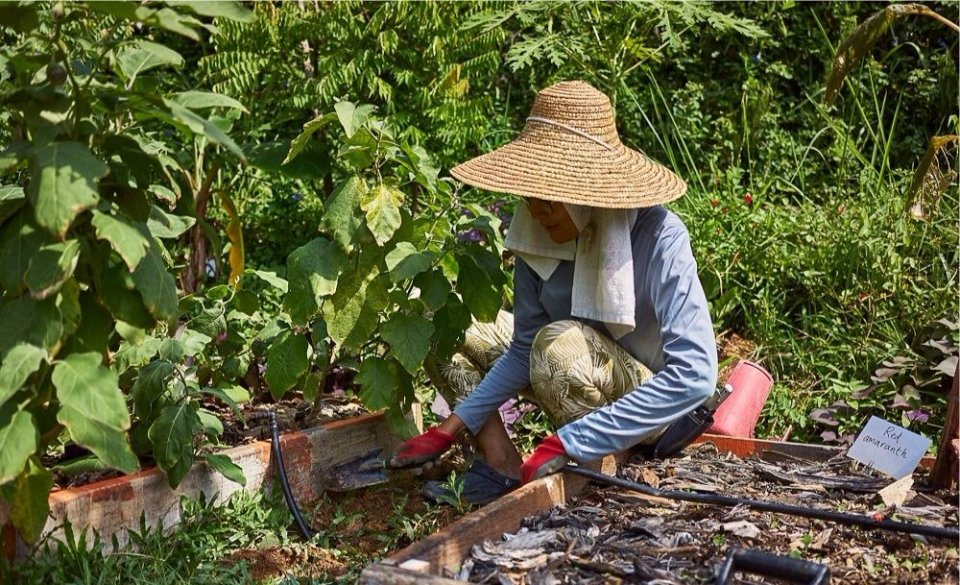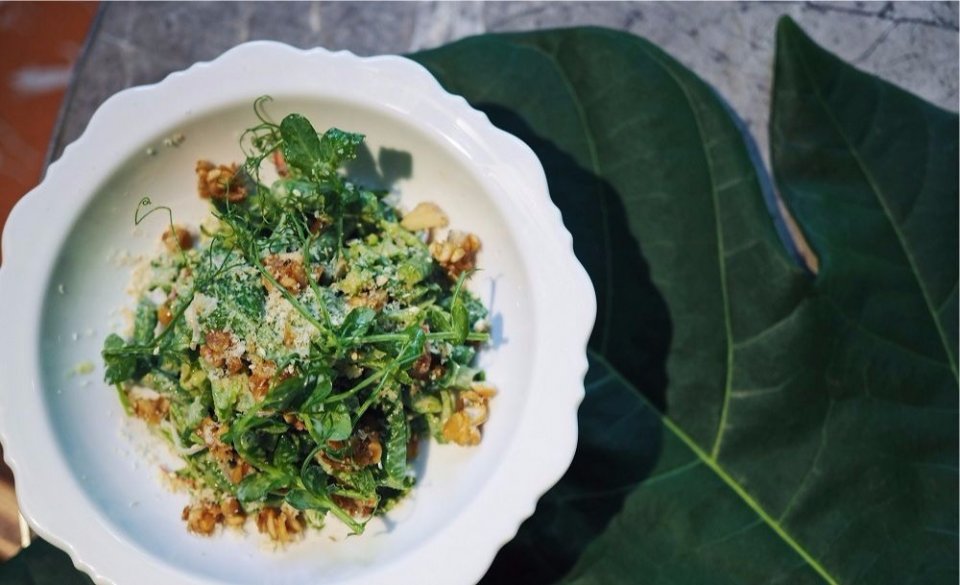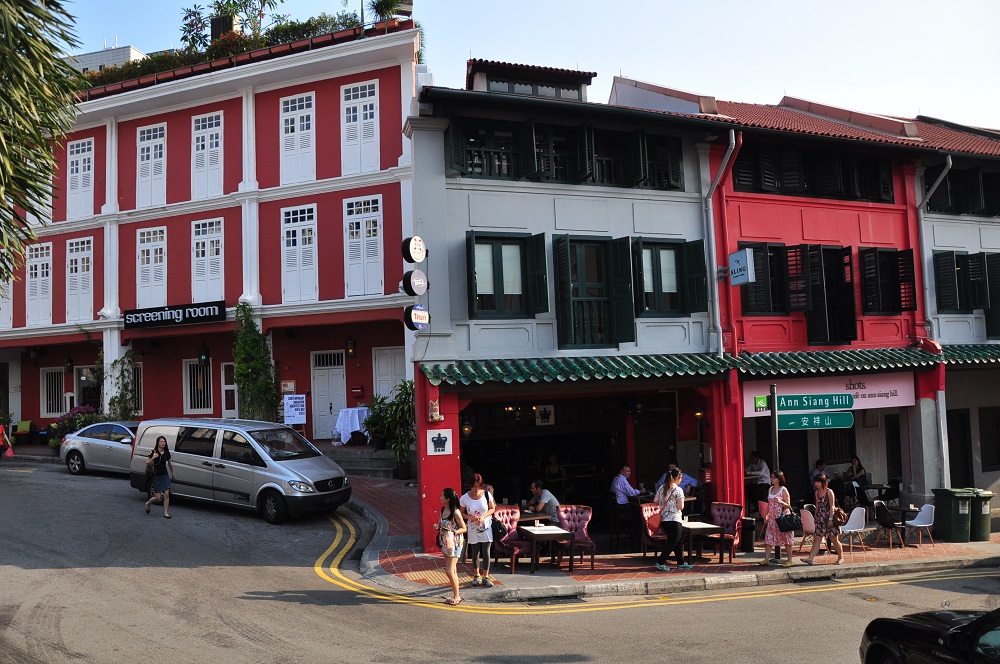Cynthia Chua wants you to support local—produce, that is, not music.
The 46-year-old founder of Spa Esprit Group has been more actively involved in the local farming scene since she opened Open Farm Community (OFC) in August 2015. The dining concept, Chua’s pet project, was started as an initiative to promote and celebrate local farming. On a 35,000 sq ft plot of green-land bordering the Dempsey dining enclave, it serves locally sourced, seasonal dishes—some even made with greens plucked from the urban farm located on-site.


Her duties are middle-man in nature; she liaises directly with the farms she sources her ingredients from, she works with the chefs to create interesting menus; she talks to her customers to walk the ground and gather feedback.
Today Chua sashays confidently through the doors of the restaurant, comfortable somehow, in three-inch wedges in her urban farm setup. It’s lunchtime, and the restaurant erupts in choruses of hellos as she flits from table to table, greeting friends and fans.
When we finally sit down, she’s personable, down-to-earth (pun fully intended) and passionate. She’s particularly zealous about beans, peppering the interview with facts on snake beans and wing beans. At one point she shares her vision of having snake beans reach the level and desirability of a “national dish” like pandan. She doesn’t quite look it, but she could just be the hero Singapore’s farm scene needs.
Garden-to-table
It seems like a gargantuan task, but Chua’s first course of action is to make local food cool again. And she doesn’t just mean coffeeshop food and heritage eats, which are already seeing glorified revivals of their own. Instead, the bubbly entrepreneur wants to see locally farmed food make its way into local and Western restaurants, and become a staple in kitchens.
As a start, she liaises with local farms to source ingredients for OFC’s dishes. Ah Hua Kelong provides the pearl grouper, Toh Thye San farm provides the chickens, and Hay Dairies produces the goat’s milk used in the restaurant’s yogurt.
“It’s about glorifying local farmers; I tell you who I work with—it’s written on the board,” Chua said.


At OFC, Edible Garden City tends the plot of land on-site, and also provides much of the vegetables (grown at their other locations) served on the menu. But with a daily patronage, it’s “impossible” to promise farm-to-table cuisine, a term that’s been technically abused thanks to sloppy PR and the rise of farmer’s markets.
“I never say farm-to-table on the menu—because I don’t really have enough land,” Chua pointed out. “If I were to pluck everything for today’s operation of 20 dishes, tomorrow the garden would be stripped; I’d have to wait four weeks to be able to take from it again.”
As such, her next move is to identify the vegetables her customers like, before bidding for land to dedicatedly grow the produce—snake beans, if you will. “Only then can that really be farm-to-table.”
No man’s land
Even with a clear plan in mind, bidding for land won’t be a straightforward task. In May earlier this year, the Agri-Food and Veterinary Authority (AVA) announced major decisions that rocked the local farm community—first, that 36 new plots of farmland in Lim Chu Kang and Sungei Tengah had been set aside for public tender. Second, that several existing farms would receive only short-term lease extensions until 2021 to continue farming on their land.
The announcement left many stuck in limbo. Those who received extensions could either wait out the rest of their lease and bid for a new plot, risking the possibility of another short lease extension; or invest in the land and risk not reaping the fruit at the end of two years.
It’s a tricky position to be caught in for both experienced and amateur farmers, but Chua sees it as a blessing in disguise—that at least the government isn’t turning their backs on farming entirely.
“Whatever the farmers feel right now maybe is transitional,” she said. “Maybe relocating them is just a phase, but the government actually does want to push agriculture.”
“If they’re saying ‘we’re not going to do anything for agriculture, we’re not afraid of food security’; then it’s a bigger challenge,” she added. “Farming will only be a dying trade in Singapore if we don’t work together.”
Lack of demand
The real problem, Chua believes, lies with lack of demand and not space. The rise of urban and rooftop farming could one day be sustainable, she says, but getting both consumers and restauranteurs to support regional produce is difficult. She cites local palates, costs and general perception as the main barriers to increasing demand for local produce.
“It’s a challenge, because people here are very used to strong flavors; it’s what the Singaporean’s palate is,” she shared. “For example, we try to cook local chicken in a way that doesn’t quite bury the taste of the chicken—because typically local produce uses a lot of sambal, a lot of curry—and people will come to me and say ‘I think the food has got no punch’.”
“But I’m not here to give you what you’re used to; I’m here to educate and create something different, to push the boundaries,” she added.
Given the smaller-scale production of farms here, vegetables and poultry farmed locally are also more expensive than produce imported from Malaysia and Indonesia. Chua lamented that many restauranteurs and chefs would rather buy from Indonesia, or indent and order from a given list for fast, cheap produce.
“It takes a different kind of chef to walk the hot garden and pluck this and that—that would be a creative chef, who understands growing, loves the garden, and wants to pluck, discover and experiment,” she said.
“We’re not brought up with an agriculture background, so I first need to drive the interest for people to be interested in local produce.”
Giving local a chance
One way to work towards her goal is to “cross-pollinate”—both in terms of ingredients and ideas.
OFC’s most recent initiative, a pop-up collaboration with French restaurant Paris Pop-Up, saw the local team working with acclaimed London chef Harry Cummins. The menu featured local produce interpreted in new ways, like chye poh flatbread and mud crab tagliolini. Feedback was encouraging, and for Chua, it opened up new techniques and ways to showcase local food.


“To people who come in and say ‘why do you want to use this kampong chicken?’, or ‘the crab is not like Sri Lankan crab’, because I’m using mud crab, I tell them—first there is a carbon footprint you need to respect. And two, the whole initiative is about celebrating local farmers and having a conversation about local produce. Wanting agriculture to thrive in Singapore means you are willing to support and be part of that movement.”
Riding on the success of the pop-up, she intends to bring in more foreign chefs for tie-ups in the future, not just to trade culinary tips, but also to move the cuisine into a more international market. Her biggest end-goal is to induce the reaction ‘I didn’t know local produce could taste like that’.
It’s an uphill task with no guaranteed payoff. But it seems like Chua’s strategy of raising the public perception of farming into a respected craft worthy of study, as opposed to simple manual labor, is already seeing dividends in small but meaningful ways.
Maybe that’s the secret to a successful #supportlocal movement.





